
Wine Culture and Information since 2002 - Volume 22
 Wine Culture and Information since 2002 - Volume 22 |
|
Issue 15, January 2004 |
Contents |
|
|
A Good Wine to Warm Winter |
|
We would like to begin this new issue of DiWineTaste by wishing a happy 2004 to our readers, continuously increasing from the day when, in the now distant September 9th, 2002, we decided to publish the first issue of our e-magazine. To you all, dear readers, old and new, we wish a happy, rich, prosperous and profitable 2004 with the hope that DiWineTaste and its services will be always of your satisfaction and enjoyment. We would also like to send our best wishes for a happy and profitable 2004 to all the producers that honored us with their trust and that allowed us to express our opinion about their wines. The year which has just passed, the 2003, has been for us a rather significant period, it has been the year in which we published our new WEB site, consolidated what we did in the past and started new services. We tried to make DiWineTaste a more versatile publication and service, more efficient than it was in the past, as always, another little but significant step forward, in the hope it will be appreciated to the ones that inevitably give a sense to what we do: our readers. Even for the 2004, the new year which has just begun, we have new ideas and new ambitions: we plan to consolidate what we did in the 2003 and to increase the quantity and the quality of the services we are currently offering. As always, your help, your support and your comments are always welcome: your opinions, either positive or negative, are valuable helps that allow us to understand what we did and what we need to do. To all of you who in the past have expressed their opinion about our publication and our services go our best and sincere thanks. We wish to continue to receive your comments and your opinions about DiWineTaste and for this we thank you in advance. We imagine that most of the people reading this editorial will have ended the 2003 and celebrated the arrival of 2004 with the usual celebrations common in our cultures: we mainly like to think you said goodbye to the old year and welcomed the new one holding a glass of good wine. After all the cold season invites, like to say, to have a higher interest in the richer and bodied beverage of Bacchus, well matchable to the foods, rich and tasty as well, of winter. Sparkling wines, uncorked at the midnight of new year's eve, will have certainly accompanied you towards the new year together with your dears, together with your families. It is a known fact, in this period, wines with bubbles are very fashionable and everywhere there is a repetition of joyous “pops”. Moreover winter is also the period in which one goes downstairs to the cellar and take those bottles of “important” wines, the wines that could be magnified with a succulent and tasty food, in short, those wines that as soon as they are poured in a glass, they make winter to seem warmer and, apparently, they help standing to the cold. Winter is also the period in which sparkling wines have a dramatic increase in selling, the repetition of the holidays between the end of December and the beginning of January, seem to be more cheerful and carefree when in our glasses we find a festival of bubbles neatly run after one another in a joyous golden wine. What about white wines? Are they really missing our glasses in this period? Probably not. Indeed, for the rich banquets prepared in occasions of the days preceding the two main holidays of this period, of course main in some countries of the world, Christmas and New Year's Day, tradition suggests that foods are to be sumptuously and richly made of fish, an ingredient recalling that famous saying “white wine goes with fish”. This “dogma”, slavishly obeyed in order not to disappoint the companions of the banquets, leaves little space to the exploration of new enogastronomical experiences, and only the most brave and curious ones are prone to some glasses of red wine while being perplexedly watched by the less braved ones. Perhaps it is in this period that many could take advantage of the richness of the tables and consider a glass of good sparkling wine matched to the many foods, instead of seeing it solely as an aperitif or the companion to be matched to desserts. This aspect inevitably makes one think about the old polemic about the matching of sparkling wines with desserts, a polemic that does not take into consideration the indisputable personal preferences, of course. Nevertheless the consumption of dry sparkling wines, or using a more appropriate term for these wines, brut sparkling wines, matched with desserts is rather and inexplicably common. We would like to know the name of the first one who launched the fashion of matching a dry wine, as well as sparkling, with a sweet food. Nevertheless it seems very obvious that for a dessert would be chosen a sweet wine, sparkling wines included. Of course the choice in these occasions is not limited, including the most renowned of sweet sparkling wines, Asti Spumante, which is well matchable with desserts, in particular with the ones made of creams, and which is certainly more appropriate of a dry sparkling wine, no matter what it is. Winter is also that period which generally makes us more enterprising and more prone to the pleasure of the table, and with that the pleasures of wine as well, and it is the period when people is more prone to stay in their houses in company of friends and of their families. In short, the good occasion to celebrate the good time spent together with a glass of good wine. Either white or red, or any other style, it does not matter, maybe it is just in wintertime we recognize to wine the socializing role that also ancient people recognized to it. Therefore let's make a toast to 2004 in the hope it will bring in every place and in every person peace, serenity and the improvement of the conditions of life for every human being and in every place of the world, in particular in the most forgotten places. Let's make a toast to 2004 because it may finally see the end of arrogance of men, of hypocrisy and poverty of the ones who think they are better and superior than others. Let's make a toast to 2004, raising our glasses, in the hope it will give us a better world for everyone. It would be truly wonderful if a “modest” glass of wine could make all that. A happy and good 2004, to everyone.
|
||||
MailBox |
|
In this column are published our reader's mail. If you have any comment or any
question or just want to express your opinion about wine, send your letters to
our editorial or fill in
the form available at
our site.
|
| I recently watched a TV show about wine where they talked about bottles to be refilled, because of ullage, and this could be the cause for oxygen to get into the bottle. This condition, it seems, can have negative effects on the qualities of wine during its aging process. Is that true? Thank you. |
| Stefano D'Angelo -- Milano (Italy) |
| Dear Mr. D'Angelo, what they said in the TV show you watched some time ago is absolutely true and right. During its stay in the bottle, a phase in which takes place the so called “refinement”, the wine undergoes a development and transformations thanks to a series of events of chemical and physical nature. Its development inside the bottle strongly depends on the keeping conditions, in particular humidity and temperature, and they contribute to accelerate or to slow down the aging processes. Among the components sensible to these conditions there is the cork, that in absence of a proper percentage of moisture, tends to shrink and therefore it lose its best hermetical properties, therefore the wine spills out from the bottle. For this reason bottles should be kept in places with adequate humidity, usually around 70%, and particular care should be paid in order to ensure the wine to be in contact with the cork in order to avoid its shrinkage. In general terms, after a variable period between 15 and 25 years, the cork tends to deteriorate and therefore this is the cause of the spilling of wine. The space freed by the wine is occupied by air, therefore oxygen, that will favor an inexorable oxidization and spoilage of the content of the bottle. Even the continuous changes of the temperature influence the diminution of the content of a bottle: high temperatures make the wine expand and therefore it will spill out of the bottle, whereas the subsequent lowering of the temperature will be cause of depressions that will favor the introduction of air inside the bottle. For this reason, after many years of aging in the bottle and as a consequence of keeping conditions that favored the diminution of the volume of wine, the bottle is opened in order to refill it and to diminish the space occupied by oxygen, at the same time the cork will be replaced as well. Many wineries which produce wines destined for long aging, offer this type of service to their customers and they usually do the proper refillings with the wine of the same vintage. |
| Why casks used for aging wine have different sizes? Does the size affects the finished product? |
| Kevin Ballard -- Fresno, California (USA) |
| Cask is a tool often used in enology during the production of a wine. The cask, generally made of oak, is used for the aging and storage of wine and, sometimes, also for the fermentation of the must. The size of casks usually vary according to the place where they have been made and their size directly affects the aging of wine and, mainly, the quantity of aromatic components and tannins passed from wood to wine. Another factor affecting the organoleptic change of wine is represented by the technique used for the making of the cask and, in particular, for how long the wood has been toasted before being used for the aging of wine. Moreover the cask is used in enology because it favors the clarification and stabilization of wine, it makes the color deeper, makes the tannins of young wine less “rough” and adds aromatic and gustatory complexity. The aging of wine in cask also favor a slow and beneficial oxidization, sometimes needed for the aging of certain types of wine. The influence of the aging in cask depends both on the way it is used and on its specific characteristics. No matter the cask is a tool rather used in the wine making, this does not mean the cask is indispensable, anyway it is wrong to assert its usage is useless, indeed, the magnificence and the elegance of many wines is often because of the aging in cask. However it should be made a proper distinction between the “intelligent” use of cask from its abuse, that is when wood aromas are practically the only ones to be perceived in a wine. It should also be remembered there are many wines, both red and white, having an indisputable high quality and remarkable elegance and they are not aged, because of a precise choice of the producer, neither in cask nor in any other wood container. |
BordeauxThe Bordeaux region is the area that more than any other else has allowed France to become a great wine producing country. A success obtained thanks to the particular conditions of the region, the attention for quality and a long tradition |
|
When France comes to mind as a wine producing country, the first region everyone thinks of is probably Bordeaux. The enological magnificence of France has been for centuries developed on the fame of the excellent wines of this region, a story long many centuries and favored by the particular environmental and climate conditions that allowed both the development of high quality wine production and a flourishing trading based on the beverage of Bacchus. In this region are being produced wines among the most expensive and renowned of the world, and right in this area originated the most imitated enological model of the world, not only for the production of red wines, but also for sweet and botrytized wines. No matter the most expensive wines of Bordeaux are very renowned in the world, they represent just a minimal part of the total production. The majority of wines produced in this region, about 700 millions of bottles per year, is not as renowned as the most important ones, they should be however considered good wines having pretty affordable prices. Bordeaux mainly produces red wines, which represent about 80% of total production, and the fame of its wines is bound to the elegance and intensity of flavors, instead of their powerful and full bodied character.
Despite the fact in the region are also produced dry white wines and sweet and botrytized white wines, Bordeaux is mainly associated to quality red wines, a success determined by some grapes which are now considered as “international” everywhere in the world. Cabernet Sauvignon, Cabernet Franc and Merlot are the three main grapes used for the production of Bordeaux's red wines, a blend which made this composition renowned all over the world as the Bordeaux Blend and that is frequently found in many wines produced in the world. To these three grapes must be included the now less used Malbec and Petit Verdot, that in the composition of Bordeaux's wines are found in few cases, opposite to what was common in the past, when these two grapes represented two important components, together with the other three. If it is true that Bordeaux is less renowned for its white wines, the same cannot be said for its sweet and botrytized wines: names like Sauternes and Barsac, two areas strictly connected to the production of these styles of wine, evoke in everybody's mind the excellence of sweet wines, or Vin Liquoreux, like the French are used to call these wines. White berried grapes cultivated in this region are Sémillon, the main ingredient for Sauternes and Barsac wines, Sauvignon Blanc, Muscadelle and Ugni Blanc, a very common grape introduced from Italy probably in the fourteenth century and known as “Trebbiano Toscano”. The region of Bordeaux is located in the western coast of France, in the Atlantic ocean, and the unique environmental and climate characteristics are mainly regulated by the estuary of Gironde and by the two rivers flowing in the region: Dordogne and Garonne. It was because of these two rivers and of the Gironde that Bordeaux became an important city for trading and commerce: the ports located along the Gironde allowed an easy docking for ships that could be loaded with many goods, and in particular wine. After they were loaded, the ships routed towards one of the most important countries of commercial interest for France: England. The environmental conditions of Bordeaux allow a favorable climate for the cultivation of vine: the tempered climate ensured by the streams originating from the Gironde and the two rivers flowing in the region, as well as the influence of the Atlantic ocean, ensure a stable climate condition also thanks to the presence of forests which isolate the region by a very rigid climate. Even the composition of the soil makes an important factor for viticulture in Bordeaux. The gravelly soils of the region ensure an excellent drainage of water, and it is because of this characteristic that one of the largest wine areas of Bordeaux is called Graves.
|
||||||||
|
The region of Bordeaux is renowned all over the world for the quantity of terms used both for the production and for the classification of wines. These terms, frequently used by producers in other wine countries of the world, represent a sort of guarantee for the quality of wine - and this partly corresponds to the truth - however there are exceptions which are confirmed only after having tasted a wine. Bordeaux is famous for being the region of château, of cru and of terroir, three terms which have allowed the enology of the region to create a quality system and to make it famous in the world. However when Bordeaux wines are being considered, inevitably are found in labels other terms and descriptions, mainly connected to quality, and they need to be understood. Experience teaches us these indications should not be considered as absolute and indisputable factors of quality. In Bordeaux, just like in every other wine region of the world, quality is a concept and a presupposition that can be realized mainly by the seriousness and the honesty of every single producer and, in particular, according to the way he or she makes use of the environmental and productive conditions of the place where the wine is being made. The classification of wines in Bordeaux is pretty vast, and sometimes confusing as well, and, as a matter of fact, there is not a unique system in force in all the region. The terms used for the classification of wines have different meaning according to the area where they are being used, moreover it should be remembered some areas in Bordeaux, just like Pomerol, do not have any classification system. The first and most famous classification system adopted in Bordeaux was established in 1855 and is exclusively about wines produced in the Médoc. The system, which is simply called classification of 1855, is based on the quality of producers and not on the production area, a concept that could contrast the terroir principle, so dear in Bordeaux. The system classifies wines in Cru Classé and in categories from first to fifth. There is Premier Cru, the first and most important category, followed by Duexième Cru, Troisième Cru, Quartième Cru and Cinquième Cru, the last category of the system. This classification is currently used for 60 châteaux of the Médoc and one of the Graves. The classification of 1855 also set specific categories for the wines of Sauternes and Barsac which were divided into Premier Cru Supérieur Classé, Premier Cru Classé and Deuxième Cru Classé. In 1953 was created the classification system for the wines of Graves, subsequently revised in 1959, in which there are no divisions but only one denomination, Cru Classé, recognized only to wines considered of superior quality and prestige. The classifications used in Bordeaux are not just these. The area of St-Emilion was classified in 1954 by using another system and it is the only one to be revised every 10 years. The higher category in St-Emilion is defined as Premier Grand Cru Classé, followed by Grand Cru Classé and, finally, Grand Cru. The first category, Premier Grand Cru Classé, is divided in two groups, simply defined as “A” and “B”, of which the “A” group represents the division of higher quality. The other renowned wine areas of Bordeaux, including Canon-Fronsac, Entre-Duex-Mers, Fronsac and Pomerol, have never been regulated by any classification system. Generally speaking, producers included in the categories of the many classification systems, obey to very high and strict productive and quality principles, as a consequence, the wines have pretty high prices. These classifications include only a minimal part of the wines produced in Bordeaux, while excluding hundreds of châteaux which are however worth of attention. For this reason in 1932 was created a special category for the châteaux of Médoc excluded in the classification of 1855 and that was called Cru Bourgeois. This classification comprised, in its original form, many divisions, however the system has been recently revised by the European Commission and currently is used the Cru Bourgeois category only. The quality of wines belonging to Cru Bourgeois is pretty vast. This category was initially established with the purpose of classifying wines for daily or frequent consumption, therefore having a lesser quality than Cru Classé. It must be however observed it is not infrequent to find in this category wines having a higher quality than wines belonging to Cinquième Cru and sometimes to Quartième Cru as well. As always quality in wine, as well as for any other product, is directly connected to the producer and to the way he or she makes wine. It should be observed, finally, that Cru Bourgeois usually have cheaper prices than Cru Classé.
|
||||
|
The Médoc is the most famous area in Bordeaux and it is located to the north of the region along the estuary of the Gironde. The fame of this area is mainly because of the notoriety of some of its appellations, represented with the names of some communes and thanks to their notoriety have made the whole area great. The Médoc is divided in two parts: the area to the north has the same name of the region (Médoc), whereas the area to the south is called Haut-Médoc, and it is just in this area that the most interesting and famous communes are found. The renowned communes of St-Estèphe, Pauillac, St-Julien and Margaux are all located in Haut-Médoc and are, as a matter of fact, the most looked for and prestigious denominations of the region: it is not by chance the majority of the most renowned châteaux of Bordeaux are located in this area. The production of Médoc is almost exclusively about red wines and the grape mainly cultivated is Cabernet Sauvignon, responsible for the body of its wines, followed by Merlot, which contributes to finesse and roundness. Another important grape of this area is Cabernet Franc, which contributes to add aromatic complexity to the wine, and in lesser part, Petit Verdot and Malbec. The first important commune located to the north of Haut-Médoc is St-Estèphe. Wines produced in this place are characterized by full body, evident tannins and require long period of aging before reaching full maturity. In order to make rounder and less aggressive wines, producers in St-Estèphe have increased the percentage of Merlot in the composition, however the main grape used here is Cabernet Sauvignon and in lower quantity, Cabernet Franc and Petit Verdot. It must be remembered that in St-Estèphe are produced the most interesting Cru Bourgeois of the region. South from here there is the commune of Pauillac, one of the most renowned and looked for areas of Médoc, and here are found three of the five châteaux classified as Premier Cru. Wines belonging to this denomination are mainly produced with Cabernet Sauvignon, which makes the higher percentage, followed by Merlot and, in lesser part, the remaining typical red berried grapes of Bordeaux. Pauillac's wines generally have a full body, an enchanting finesse and elegance, and give their best after a proper aging in bottle of about ten years. Moving to the south there is the commune of St-Julien, renowned for the quality of its excellent wines. St-Julien is a pretty small commune, however here is found the higher concentration of châteaux belonging to the many Cru Classé as well as many excellent Cru Bourgeois. Wines produced in this commune are renowned for their full body, class and elegance and are mainly produced with Cabernet Sauvignon, which represents the higher percentage, Merlot and Cabernet Franc. South from St-Julien there are the two communes of Listrac and Moulis, located to the west of the Gironde and therefore they do not benefit in a relevant way of its influence. The less favorable conditions, as opposed to the other famous communes, in particular a lesser drainage of water and the different composition of the soil, make the wines of these two communes less valuable, however it is not rare to find good wines, in particular in Moulis. To the south and near the coast of Gironde, there is Margaux, one of the most famous and important communes of Haut-Médoc. Thanks to the particular conditions of the soil, Margaux's wines are famous for their elegance and finesse, as well as for their excellent aromas. Moreover Margaux's wines are also powerful and full bodied, along with the other characteristics, make these wines among the most interesting and elegant ones of the region. Grapes mainly used in Margaux's wines are Cabernet Sauvignon, Merlot and Cabernet Franc, as well as a small percentage of Petit Verdot.
|
|
South from Médoc are found the Graves, an area of primary interest and of reference for Bordeaux wines. As opposed to the other areas of the region, in the Graves the production can be considered divided between white wines and red wines. This area is famous for the favorable composition of the soil, characteristic from which originates its name, Graves, and in this area, near the city of Bordeaux, there is the renowned wine area of Pessac-Léognan, where are produced the best red and white wines of Graves. Thanks to the quality of its wines, since 1987 the area of Pessac-Léognan has acquired the recognition of AOC (Appellation d'Origine Contrôlée). The main red berried grape of Graves is Cabernet Sauvignon, however in this area Merlot and Cabernet Franc are pretty common as well. As opposed to the other areas of Bordeaux, in the Graves the production of white wine is considerable and often wine lovers identify the whole area with white wines. Grapes used for the production of white wines in this area are Sémillon, responsible for richness, structure and the capacity of aging, and Sauvignon Blanc, which contributes to crispness and aromatic elegance of wines.
|
|
South from Graves, following the course of the Garonne river, there are the two most renowned communes of Bordeaux for the production of sweet and botrytized wines: Sauternes and Barsac. The production of wines in these two areas is almost exclusively about sweet wines produced with grapes affected by noble rot, Botrytis Cinerea, renowned and famous everywhere in the world. Of the two communes, Sauternes is the largest, about four times than the smaller Barsac, as well as the most famous one, however in both communes are produced excellent wines. Sweet wines produced in these areas are characterized by an excellent elegance, as well as an incredible balance and aromatic and gustatory complexity. Both communes have excellent conditions for the development of Botrytis Cinerea, or Pourriture Noble, like the French are used to call it, thanks to the influence of the Garonne and Ciron rivers. Wines of Sauternes and Barsac are also surprising for their incredible longevity: not only they wonderfully age for more than 30 years, but what surprises is that during the process of aging they acquire complexity and an amazing richness in aromas and flavors. Grapes used for the production of these superb botrytized wines are Sémillon, which represents the higher percentage, with small adding of Sauvignon Blanc and, sometimes, Muscadelle. In these two communes are also produced, with the same grapes, white dry wines, characterized by good body, as well as a small quantity of red wines, usually not available outside of the production places, belonging to the denomination Graves AOC.
|
|
In the eastern part of the region, far from the estuary of the Gironde, is located an area of primary enological interest and it is considered among the most important ones of Bordeaux: Saint-Emilion. This area belongs to the Libournais, the region neighboring the city of Libourne, along the course of the Dordogne river, and here are exclusively produced red wines. As opposed to the Médoc, the soil of St-Emilion is mainly hilly, a condition which influence the style of the wines produced in this area. The main grapes are Merlot and Cabernet Franc, followed, in rather lower percentages, by Cabernet Sauvignon and Malbec. The wines of St-Emilion are pretty different from the ones produced in the Médoc, a characteristic which depends both on the different composition of the soil and on the higher usage of Merlot grape. The higher presence of Merlot makes St-Emilion wines more round and soft than the ones of the Médoc, moreover their class and elegance made them renowned and looked for by many wine lovers.
|
|
In the region of Libournais, west from St-Emilion, there is the small area of Pomerol. Despite the fact Pomerol is a rather small area, it is considered among the most famous and important wine areas of Bordeaux. Just like in the neighboring St-Emilion, the production in Pomerol is exclusively about red wines and the main grapes are Merlot and Cabernet Franc. Rarely, and in small quantities, in the wines of this area is used Cabernet Sauvignon. As opposed to the other important wine areas of Bordeaux, Pomerol does not have any classification system for its wines. Pomerol wines, thanks to the environmental conditions and to the use of Merlot grape, are very elegant and round, have an excellent body with enchanting aromas and taste, characteristics that allowed these wines to become renowned and famous in every part of the world.
|
|
The region of Bordeaux is divided in tens of denominations of which some are worth to be mentioned besides the ones already discussed. The denominations mentioned in this paragraph lack of the same environmental conditions and the best terroir typical in the main areas, therefore the wines produced are generally more “simple”, even though with some exceptions. East from the city of Bordeaux there is the large area of Entre-Duex-Mers where are mainly produced dry white wines with Sémillon, Sauvignon Blanc and Muscadelle grapes. In the south there are the areas of Cérons, Loupiac and Ste-Croix-du-Mont where are produced good sweet wines with Sémillon, Sauvignon Blanc and Muscadelle grapes. North from the city of Bordeaux there are the areas of Côtes de Bourg and Côtes de Blaye, two hilly wine areas among the oldest of the region, where are produced red wines, not comparable with the ones of the Médoc, mainly with Merlot grapes. Finally, west from Pomerol there are the two areas of Fronsac and Canon-Fronsac in which are exclusively made red wines with Merlot and Cabernet Franc as well as small quantities of Cabernet Sauvignon.
|
Exercises for Sensorial TastingThe practice of sensorial and organoleptic tasting of wine requires experience and continuous training, a patient task indispensable for improving the taster's capacities |
|
The sensorial and organoleptic tasting of wines is a practice requiring lots of commitment, concentration and a continuous training, and just like in many other activities, the knowledge of theoretics notions just represents a fundamental factor. The knowledge of theory and of the techniques of tasting is certainly useful and represents a valid tool and a starting point in order to plan a good strategy in the sensorial evaluation. However the practice of tasting requires lots of experience and will, last but not the least, the capacity of being curious as well as having a good attitude to investigation by means of one's own senses. These capacities can be improved and increased thanks to a continuous training done with a constructive and comparative strategy. Tasting the highest possible number of wines is fundamental, moreover tasting wines from many producers, different areas, different grapes, different qualities, allows the taster to acquire experience by means of a pretty vast knowledge. After all, wine cannot be understood just by reading it on books: what improves the skill of a taster is what has been poured on his or her glass and that was “read” by his or her senses, and most important, the taster knows the wine because he or she is able to recognize it.
|
|
A good tasting session can be recognized by the way it was organized and, first of all, by the intended goal of the event. Not all the tasting sessions offer the right occasions for improving the taster's capacities: sometimes the evaluation of wine is done, both for practical reasons and for professional needs, in conditions which are not favorable for educational purposes. However it is possible to organize specific tastings with the purpose of improving our capacities and our experience while ensuring the right concentration, attention and method in order to get good educational results. The essential condition which allows the achievement of this result is, first of all, the availability of a tranquil room with no disturbing elements where the sensorial tasting of wine can be done in a profitable way. The experience of the taster is based on many factors and on the many educational opportunities he or she can take into advantage in order to improve culture and experience, sad to admit, never enough, always and however improvable. By considering the practice of tasting affects the emotional and sensorial aspect of the one who is doing it, as well as considering that every wine makes an unique experience to be added to all the previous ones, a fundamental role is played by the capacity of remembering every experience. These experiences will be useful in future tastings and will help to better compare and recognize. On this regard it is certainly useful and advisable to have at hand, during the tasting sessions, tools which allow to take note of the many aspects of the sensorial tasting, such as sheet of papers or a computer.
Taking notes of the tastings is an extremely useful practice provided they are properly organized and classified: they will make an important studying tool and they will represent a precious “historical memory” of all experiences. The operation of taking time for writing notes on a sheet of paper, or on a specific computer application, about the impressions and evaluations of a wine helps, as a matter of fact, to consciously think about the characteristics found. For this purpose the many wine tasting associations have realized proper forms which allow the taster to take note of the sensorial evaluations in a profitable and organized way. In case it is not possible to have specific forms for taking notes about sensorial evaluations, it will be enough to make use of a normal sheet of paper where the taster will write all the impressions and all the characteristics found during the tasting. It will be good to divide the sheet in specific sections where in every one of them will be written considerations about appearance, olfactory and gustatory evaluations, as well as general considerations about the wine. For example, it will be taken note of the color and of transparency, of the nature of aromas and of their quality, including the description of aromas found in a wine, body, intensity of flavors and balance, finally, a personal opinion and judgment of the wine based on the many phases of the tasting. Taking note of the evaluations about a wine is also useful, even when done in less favorable conditions, every time there is the occasion to taste a wine, such as in restaurants or in a wine fair. In these specific cases will be taken notes about the main characteristics of wines by making use of personal symbols or abbreviations. Another characteristic every taster, or at least every professional taster, should develop is the capacity of expressing objective judgments. This capacity can be developed by comparing one's own sensorial evaluations with the ones of others. Useful exercises for this purpose can be done by organizing group tastings, where every participant, in silence and by himself or herself, will do the organoleptic tasting of the wine and will take note of the impressions and judgments in a sheet of paper. In group tastings it is essential that every participant will do the evaluation by himself or herself and without disturbing others and without being cause of useless influences on the judgment of others. At the end of the evaluation of a wine, or all the wines, the participants will be invited to express their opinions on a specific wine which will be compared with the evaluations of others. This exercise is useful to test how one's own judgment meets the objectivity of others and helps to better understand the wine being examined. It should be however remembered that every individual has proper and distinct sensorial capacities: what can be perceived by some can be imperceptible for others and vice versa. Group tasting, and when possible personal tasting as well, can be done “blinded”, that is without knowing in advance the wines to be evaluated, in order to avoid useless prejudices both on the wine and on the producer. On this regard it is a good practice to eliminate any clue of recognizability from the bottle in order to avoid tasters to identify the wine when it is being poured in the glass. A good method is to completely remove the capsule from the bottle and to subsequently put it in a non transparent and sufficiently large bag in order not to show the shape of the bottle. It is not advisable to wrap bottles in aluminum foil, or other materials, because the shape of the bottle will be clearly shown and visible to the taster and this could give him or her information, of course prejudicial, on the identity of the wine. It should be considered that many producers market their wines in bottles having personalized shapes, therefore recognizable, as well as it is frequent the use of specific shapes in specific areas or wines. For example Bordeaux bottle is generally used for red wines produced in certain areas, whereas flute bottle is frequently used for white wines, in particular for wines produced in Germany, Alsace and North Italy. A large and non transparent bag will hide these details and will allow the evaluation of a wine without the influence of useless prejudices. Despite it is less frequent, it should be however remembered some producers are used to personalize both the neck and the opening of the bottle and therefore giving recognizable marks that cannot be hidden in a bag. In this specific case it will be good to pour in advance the wine in tasters' glasses and in their absence, and therefore they will be served without showing the bottle. The purpose of blind tastings is to ensure the highest possible objectivity without being influenced by any factor saved what the wine can communicate to the one who is going to evaluate it. Blind tastings are extremely useful to refine and improve the taster's capacities: not knowing the wine in advance forces the taster to investigate and to analyze every single aspect without having any “reference” and while making his or her own “sensorial scenario” from the single factors which are progressively found. During the evaluation of a wine, no matter how it is being presented, it will be good for the taster to write down and to considerate only the aromas which are really found and of which he or she is certain of. In other words it is good for the tasters, in order to truly improve his or her capacities, to evaluate a wine in a honest and correct way, both in regards of the wine being evaluated and in respect of himself or herself, and all the uncertain aspects and characteristics will not be considered. Every tasting and every evaluated wine always and however make an unique occasion from which there is always something new to learn, provided the taster wants to learn something new. Neophyte tasters, when they are about to evaluate a wine, often try to recognize and to find aromas they know they are able to recognize, and despite this is very rewarding to them, this practice does not allow, as a matter of fact, any kind of progress. There are aromas which are clearly more simple to recognize than others, because they are more familiar and common, and they usually cover the others while making them “invisible”. Evaluating the aromas of wine is, more or less, like listening to a symphony: the overall result is represented by all the instruments of the orchestra, including the ones apparently less evident and that together with the primary ones make a remarkable musical impact. As it is a good practice to try to individuate the sound of the “second violin” or of “contrabass” in order to better appreciate a musical piece, at the same way it is a good practice to try to individuate the more delicate and less “evident” aromas of a wine, often true indicators of the real character and personality of a wine. Once all the “easy aromas” have been recognized, the taster will try to go beyond and to recognize what it is “behind” and which contributes to the overall aromatic composition and personality of a wine.
|
||||||||||||
|
Comparative tastings of wines are always useful exercises for the improvements of the taster's skills. The types of comparative tastings are virtually endless and each one of them allows the individuation and understanding of the differences between the many wines and the peculiar characteristics of each one. An useful exercise for neophyte tasters consists in the comparative evaluation of mono varietals wines, that is produced with just one grape, and belonging to the same category, such as white wines or red wines. This useful exercise allows the taster to easily individuate the organoleptic qualities of the single grapes: the comparison with other wines should make easier the perception of the differences. It could be done, for example, a comparative tasting of four white wines, Gewürztraminer, Sauvignon Blanc, Chardonnay and Riesling, as well as four red wines, Sangiovese, Cabernet Sauvignon, Merlot and Pinot Noir. This exercise allows the taster to improve his or her capacity in the recognition of the specific characteristics of every grape. The next exercise consists in the comparative tasting of wines produced with different blends, that is made of different wines or grapes, and of which it is known the composition. In this tasting it will be tried to individuate the characteristics of every grape and how it contributes to the overall personality of the wine. For example it could be done a comparative tasting of three wines in which the same grape is blended with others. For example they could be used three wines where the Chardonnay is always present and respectively blended with Sauvignon Blanc, Malvasia Bianca and Pinot Blanc. As for red wines they could be used, for examples, three wines in which Cabernet Sauvignon grape is always present and respectively blended with Sangiovese, Merlot and Montepulciano. In this type of exercise it is good to pay attention to every single aspect of the tasting, in particular to the olfactory and gustatory evaluation, while trying to understand how the single grapes influence the sensorial and organoleptic characteristics of the wine. Among comparative tastings are very useful the so called “vertical tastings” and “horizontal tastings”. A vertical tasting consists in evaluating a specific wine produced by the same winery and compared with samples of different vintages. This tasting allows the evaluation of many important aspects, such as the evolution of the wine over the time, the constancy and the reliability of a producer, the influence of meteorological conditions of a specific year. A horizontal tasting consists in the evaluation of different wines belonging to the same type, produced with the same grapes, and preferably in the same areas, belonging to the same vintage but produced by different wineries. An example of horizontal tasting is represented by the evaluation of four Chablis 2000 produced by four different wineries. The purpose of horizontal tasting is to obtain an overall and reliable evaluation about a specific wine and about the quality of a specific vintage, as well as evaluating the specific quality of every producer.
Comparative tastings are extremely useful for the improvement of the knowledge about the effects of the area of production on a specific wine and on specific grapes. One of the most interesting aspects is represented by the study of the organoleptic differences of wines produced with the same grape but coming from different areas, either neighboring or distant. One of the fundamental principles of quality in wines is represented by the influence of the environmental and climate conditions of every single territory, what the French calls “terroir”, and the study of these differences can be done by means of comparative tastings. For example, they can be considered three wines produced with Sangiovese grape, produced in Umbria, Tuscany and Emilia Romagna, and compared one each other while investigating on the organoleptic differences. In this type of comparison it is good to evaluate wines produced by wineries having same quality standards: it would not make much sense, in regard to the purpose of this study, to compare a high quality wine with a low quality wine. Subsequently the comparison can be done with wines produced in neighboring areas, for example communes of Chianti Classico, having the same quality and produced in different places.
|
||||||||
|
An aspect which is not very considered by neophyte tasters, even worse, not very considered in many courses about the sensorial tasting of wine, is the important help that can be offered by the tasting of a wine having some defects or faults. On this regard, there are also some who are convinced, to be honest in a pretty hypocrite way, a great taster is the one who has always and however tasted precious, expensive and excellent wines. To tell the truth, a great taster is the one who knows the wine in all its aspects, and this necessarily includes the study and the tasting of defective and low quality wines, as well as wines having high and impeccable quality. After all, how can be recognized something having a truly high quality when something truly opposite and inferior has never been tasted? A good quality wine is, first of all, a wine not having faults. The capacity of recognizing the absence of faults requires the capacity of recognizing faults and to be able to recognize their presence in a wine. For example, how can a taster recognize the so called “corkiness” when he or she never met this fault in any wine? How can he or she recognize the “vinegar” smell in a wine, a sign meaning the imminent transformation into vinegar, if he or she never met this fault? The next time you are about to uncork a bottle of wine and you find it smells “corky”, after the initial disappointment and the consequent frustration, pay attention to that smell and treasure it, try to learn as much as possible from that fault and from any other fault. It is also by these things it can be told a good taster from a mediocre one, or if you like, a real connoisseur and intelligent wine lover from a conceited and ignorant drinker of labels.
|
Wines of the Month |
|
|
|
Score legend Prices are to be considered as indicative. Prices may vary according to the country or the shop where wines are bought |
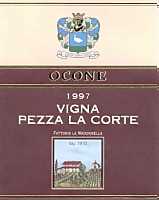
|
|
Aglianico del Taburno Vigna Pezza la Corte 1997 |
|
| Ocone (Italy) | |
| Grapes: Aglianico | |
| Price: € 11,00 | Score: |
| The wine shows a brilliant ruby red color and nuances of garnet red, moderate transparency. The nose reveals intense, clean, pleasing and elegant aromas which start with aromas of black cherry, plum and dried violet followed by good aromas of carob, blueberry, licorice and pleasing hints of vanilla and leather. In the mouth has good correspondence to the nose, a slightly tannic attack however well balanced by alcohol, good body and intense flavors. The finish is persistent with good flavors of plum and black cherry. A well made wine. This Aglianico ages for one year in steel tanks followed by about nine months in barrique. | |
| Food Match: Braised and stewed meat with mushrooms, Roasted meat, Hard cheese | |
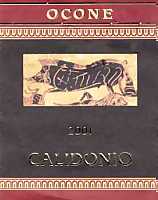
|
|
Taburno Piedirosso Calidonio 2001 |
|
| Ocone (Italy) | |
| Grapes: Piedirosso, Aglianico | |
| Price: € 15,00 | Score: |
| The wine shows an intense ruby red color and nuances of ruby red, moderate transparency. The nose denotes intense, clean, pleasing and elegant aromas which start with aromas of black cherry and blueberry followed by aromas of carob, cyclamen, licorice, blackberry, plum and dried violet. In the mouth has good correspondence to the nose, a slightly tannic attack however balanced by alcohol, good body and intense flavors. The finish is persistent with flavors of plum, black cherry and blueberry. Calidonio ages for 6 months in steel tanks and for 3 months in bottle. | |
| Food Match: Roasted meat, Stewed meat with mushrooms, Hard cheese | |
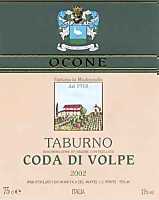
|
|
Taburno Coda di Volpe 2002 |
|
| Ocone (Italy) | |
| Grapes: Coda di Volpe | |
| Price: € 6,00 | Score: |
| The wine shows a brilliant greenish yellow color and nuances of greenish yellow, very transparent. The nose denotes intense, clean and pleasing aromas that start with aromas of hawthorn, pear and apple followed by aromas of lemon, hazelnut, peach and grapefruit. In the mouth has good correspondence to the nose, a crisp attack however balanced, agreeable and intense flavors. The finish is persistent with flavors of lemon, pear and peach. | |
| Food Match: Pasta and risotto with vegetables, Boiled fish, Aperitif | |
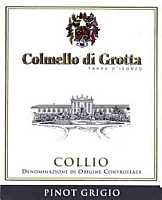
|
|
Collio Pinot Grigio 2002 |
|
| Colmello di Grotta (Italy) | |
| Grapes: Pinot Grigio | |
| Price: € 8,00 | Score: |
| The wine shows a pale straw yellow color and nuances of greenish yellow, very transparent. The nose reveals good personality with intense, clean, pleasing, elegant and refined aromas which start with hints of peach and elder followed by pleasing hints of hawthorn, chamomile, broom, litchi, apple, pear and pleasing hints of sage and tomato leaf. In the mouth has good correspondence to the nose, a crisp attack and however well balanced by alcohol, good body, intense flavors, agreeable. The finish is persistent with good flavors of peach, pear and apple. A well made wine. | |
| Food Match: Crustaceans, Roasted fish, Pasta and risotto with fish, Sauteed white meat | |
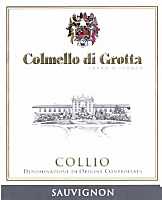
|
|
Collio Sauvignon 2002 |
|
| Colmello di Grotta (Italy) | |
| Grapes: Sauvignon Blanc | |
| Price: € 8,00 | Score: |
| The wine shows a pale straw yellow color and nuances of greenish yellow, very transparent. The nose reveals intense, clean, pleasing and elegant aromas which start with hints of elder, peach and pineapple followed by good aromas of banana, hawthorn, jasmine, litchi and pear. In the mouth has good correspondence to the nose, a crisp attack and however balanced by alcohol, good body, intense flavors, agreeable. The finish is persistent with flavors of peach, pineapple and pear. This Sauvignon Blanc ferments and ages in steel tanks. | |
| Food Match: Fried fish and crustaceans, Pasta and risotto with fish and crustaceans, Broiled fish | |
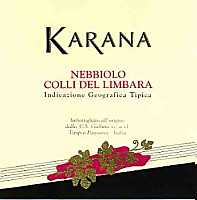
|
|
Karana 2001 |
|
| Cantina Sociale Gallura (Italy) | |
| Grapes: Nebbiolo (70%), Sangiovese (20%), Cabernet Sauvignon (10%) | |
| Price: € 5,00 | Score: |
| This wine shows an intense ruby red color and nuances of ruby red, moderate transparency. The nose reveals intense, clean and pleasing aromas that start with aromas of black cherry, violet and plum followed by aromas of blueberry and hints of licorice and cocoa. In the mouth has good correspondence to the nose, a slightly tannic attack however balanced, good body and intense flavors. The finish is persistent with flavors of black cherry, plum and blueberry. Karana ages for about 5-8 months. | |
| Food Match: Roasted and broiled meat, Hard cheese, Stuffed pasta | |
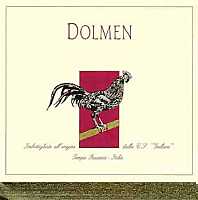
|
|
Dolmen 2000 |
|
| Cantina Sociale Gallura (Italy) | |
| Grapes: Nebbiolo (70%), Sangiovese (10%), Syrah (10%), Cabernet (10%) | |
| Price: € 15,00 | Score: |
| The wine shows an intense ruby red color and nuances of garnet red, little transparency. The nose reveals intense, clean, elegant and pleasing aromas which start with hints of black cherry, plum jam and toasted wood followed by good aromas of blueberry, blackberry, black currant, licorice, vanilla and a pleasing hint of cut grass. In the mouth has good correspondence to the nose, a slightly tannic and a slightly crisp attack however balanced, good body, intense flavors. The finish is persistent with flavors of plum jam, black cherry and blueberry. Dolmen ages for 15-20 months in barrique. | |
| Food Match: Roasted meat, Braised meat, Hard cheese | |
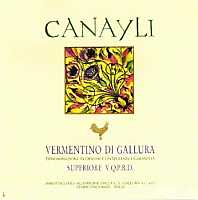
|
|
Vermentino di Gallura Superiore Canayli 2002 |
|
| Cantina Sociale Gallura (Italy) | |
| Grapes: Vermentino | |
| Price: € 7,00 | Score: |
| This wine shows a brilliant straw yellow color and nuances of straw yellow, very transparent. The nose reveals good personality and intense, clean, pleasing and elegant aromas which start with aromas of hawthorn, hazelnut and pear followed by good aromas of almond, pineapple, jasmine, apple, peach and hints of honey and green pepper. In the mouth has good correspondence to the nose, a crisp and slightly round attack however well balanced by alcohol, good body, intense flavors, agreeable. The finish is persistent with good flavors of peach, pear and almond. This Vermentino ages for 4-6 months. | |
| Food Match: Roasted fish, Roasted white meat, Pasta and risotto with fish, Soft cheese | |
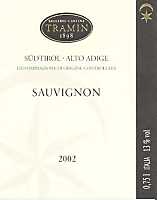
|
|
Alto Adige Sauvignon 2002 |
|
| Produttori Termeno (Italy) | |
| Grapes: Sauvignon Blanc | |
| Price: € 6,30 | Score: |
| The wine shows a pale straw yellow color and nuances of greenish yellow, very transparent. The nose denotes intense, clean, pleasing and elegant aromas that start with pleasing hints of peach and elder followed by good and intense aromas of acacia, pineapple, banana, litchi and pear. In the mouth has good correspondence to the nose, a crisp attack and however balanced by alcohol, good body, intense flavors, agreeable. The finish is persistent with flavors of peach, litchi and pineapple. This wine ferments in steel tanks. | |
| Food Match: Fried fish and crustaceans, Pasta and risotto with fish and crustaceans, Broiled fish | |

|
|
Alto Adige Pinot Nero Schiessstand 2000 |
|
| Produttori Termeno (Italy) | |
| Grapes: Pinot Nero | |
| Price: € 16,00 | Score: |
| The wine shows a brilliant ruby red color and nuances of garnet red, moderate transparency. The nose reveals good personality and intense, clean, pleasing, elegant and refined aromas which start with hints of cherry and raspberry followed by good aromas of strawberry jam, plum, dried rose as well as pleasing hints of licorice, cocoa and geranium. In the mouth has good correspondence to the nose, a slightly tannic attack and a pleasing crispness however well balanced by alcohol, good body, intense flavors, very agreeable. The finish is persistent with flavors of cherry, raspberry and strawberry. A well made wine. This Pinot Noir ages for 9 months in barrique followed by more aging in cask. | |
| Food Match: Roasted meat, Hard cheese, Stewed meat with mushrooms | |

|
|
Alto Adige Gewürztraminer Nussbaumer 2002 |
|
| Produttori Termeno (Italy) | |
| Grapes: Gewürztraminer | |
| Price: € 14,20 | Score: |
| The wine shows an intense straw yellow color and nuances of straw yellow, very transparent. The nose reveals personality with intense, clean, elegant, refined and pleasing aromas which start with a clean and typical aroma of grape, peach, honey and litchi followed by good and clean aromas of acacia, apricot, pineapple, orange, banana, passion fruit, lily, pear, white rose and sage. In the mouth has excellent correspondence to the nose, a crisp and pleasing round attack however well balanced by alcohol, good body, intense flavors, very agreeable. The finish is very persistent with long and clean flavors of peach, honey, litchi, banana and grape. A great wine. | |
| Food Match: Roasted and spiced fish, Roasted white meat, Hard cheese | |

|
|
Soave Classico Superiore Contrada Salvarenza Vecchie Vigne 2001 |
|
| Gini (Italy) | |
| Grapes: Garganega (90%), Chardonnay (10%) | |
| Price: € 17,00 | Score: |
| This wine shows a pale golden yellow color and nuances of golden yellow, very transparent. The nose reveals good personality with intense, clean, refined and pleasing aromas which start with aromas of hawthorn, honey and ripe apple followed by good aromas of pineapple, orange, broom, pear, peach and a pleasing hint of vanilla. In the mouth has good correspondence to the nose, a crisp and pleasing round attack however well balanced by alcohol, good body, intense, flavors, agreeable. The finish is persistent with flavors of apple, pear and peach. A well made wine. Salvarenza Vecchie Vigne ferments in barrique and ages for some months. | |
| Food Match: Pasta and risotto with mushrooms and meat, White meat, Roasted fish, Soft cheese | |
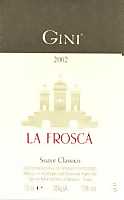
|
|
Soave Classico Superiore La Froscà 2002 |
|
| Gini (Italy) | |
| Grapes: Garganega (90%), Chardonnay (10%) | |
| Price: € 12,50 | Score: |
| This wine shows a pale straw yellow color and nuances of greenish yellow, very transparent. The nose reveals good personality with intense, clean, pleasing and elegant aromas which start with hints of acacia, peach and banana followed by pleasing and good aromas of broom, litchi, quince, pear and almond. In the mouth has good correspondence to the nose, a crisp and pleasing round attack however well balanced by alcohol, good body, intense flavors, agreeable. The finish is persistent with good flavors of banana, peach and pear. A well made wine. A small part of this wine ferments in barrique. | |
| Food Match: Pasta and risotto with vegetables, Soft cheese, Broiled and sauteed fish | |
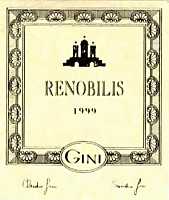
|
|
Recioto di Soave Renobilis 1999 |
|
| Gini (Italy) | |
| Grapes: Garganega (70%), Chardonnay (30%) | |
| Price: € 28,00 - 375ml | Score: |
| The wine shows an amber yellow color and nuances of amber yellow, very transparent. The nose reveals intense, clean, pleasing and intense aromas that start with hints of dried apricot, dried fig, hazelnut and honey followed by intense and good aromas of candied fruit, quince jam, peach jam, raisin, vanilla and a pleasing hint of enamel. In the mouth has good correspondence to the nose, a sweet and round attack however well balanced by alcohol, good sweetness, good body, agreeable. The finish is persistent with flavors of dried apricot, quince jam and honey. Renobilis ages for 3 years in cask. | |
| Food Match: Confectionery, Dessert with dried fruit and jams, Hard and piquant cheese | |
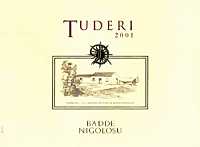
|
|
Tuderi 2001 |
|
| Tenute Dettori (Italy) | |
| Grapes: Cannonau | |
| Price: € 29,00 | Score: |
| The wine shows a brilliant ruby red color and nuances of ruby red, moderate transparency. The nose reveals intense, clean and pleasing aromas which start with hints of cherry and plum followed by good aromas of raspberry, carob, blackberry, dried violet, black cherry and hints of licorice. In the mouth has good correspondence to the nose, a slightly tannic attack and however balanced by alcohol, good body, intense flavors. The finish is persistent with good flavors of raspberry and black cherry. | |
| Food Match: Sauteed meat, Roasted meat, Hard cheese | |
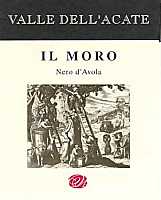
|
|
Il Moro 2001 |
|
| Valle dell'Acate (Italy) | |
| Grapes: Nero d'Avola | |
| Price: € 10,00 | Score: |
| The wine shows a brilliant ruby red color and nuances of ruby red, little transparency. The nose denotes intense, clean and pleasing aromas which start with hints of black cherry, blackberry and blueberry followed by good aromas of plum, violet and licorice. In the mouth has good correspondence to the nose, a slightly tannic attack and however balanced by alcohol, good body, intense flavors. The finish is persistent with flavors of black cherry and blueberry. This wine ages in steel tanks and in bottle for at least 9-12 months. | |
| Food Match: Broiled meat and barbecue, Sauteed meat with mushrooms, Stuffed pasta, Hard cheese | |
BenantiThe dynamic Sicilian winery has always paid attention to the revaluation of the great and historical vines of Etna. A noble work which is realized in the quality and in the elegance of its wines |
|
Wines produced in the enchanting area of Etna, at the feet of the giant volcano, have represented for centuries an important and prestigious factor for the Sicilian enology. Despite the difficulties because of the soil strongly conditioned by the eruptions of the volcano Etna, man has been successful in transforming the lavic landscape into one of the most rich agricultural areas of Sicily, and in particular, of valuable vineyards which have been capable of producing generous wines mentioned by many writers in the course of the history of humanity. Vine has been cultivated since many centuries on the volcano Etna, and its particular and unique climate has greatly favored the production of wines which have been renowned from the very beginning and contributed to the development of a strong and well established wine culture in the area. The wine in the Etnean area has always represented an important social and commercial factor. Around the year 1880, the province of Catania had the record of whole Sicily for having the largest acreage destined to viticulture and to the production of wine, about one million of hectoliters at those times.
The production of wine in the Etnean area represented an important commercial resource and most of the wine was loaded on ships and routed towards France, North Italy and in the American continent. In order to ease the transportation of wine in the Sicilian island, it was even build the Circumetnea railroad. The importance of wine was so high that they established at Riposto, a town in the commune of Catania, in 1886 the Enological Bureau and in 1881, by a Royal Decree, was established in Catania the Enological School, among the first ones of Italy, which today is called Technical and Specialized Institute for Agriculture, Viticulture and Enology. The fame and prestige of the wines of the Etnean area, probably known since the fifth - third century B.C., has been successful because of the particular and historical local grapes, of which many have been destroyed as a consequence of the phylloxera, as well as the favorable environmental and climate conditions, factors that are capable of producing high quality wines even today. In 1988 Dr. Giuseppe Benanti, continuing the ancient passion of its family, started a study for the revaluation of the wine and viticultural potentialities of the Etnean area, a study which lasted for three years and that allowed him to rediscover and revaluate the prestigious grapes of his land while making them among the most important ones of Italy. This certainly is one of the great merit to be bestowed to the precious and exacting work of Benanti winery, the will to save from extinction many of the autochthonous grapes of Etna and that for centuries have been capable of producing valuable wines. Thanks to the collaboration of wine maker Salvo Foti, as well as the common passion for grapes and wines of Etna, Dr. Giuseppe Benanti has certainly been successful in the revaluation of the historical grapes of Etna such as Nerello Mascalese, Nerello Cappuccio, Carricante and Minnella, a white berried grape which was truly in danger of extinction.
Currently half of the grapes used at Benanti winery for the production of their wines are from vineyards of the estate whereas the remaining part is from vineyards located in the north, east and south sides of the volcano Etna, not belonging to the winery but directly controlled by Benanti in every single phase of the cultivation. These vineyards, generally having an average area of about one hectare, allow Benanti winery to have high qualities grapes coming from different areas, and in particular, represents a need forced by the particular environmental conditions of the area of Etna. In 1991, the first year of production, Benanti winery produced about 20,000 bottles of Etna DOC wine. In 1993, thanks to the particular and favorable vintage, the production was doubled and from that year up to 1996 the production has been of 50,000-60,000 bottles per year. From 1997 the production has increased up to the current figures of 150,000-180,000 bottles. The current production if mainly exported in the European countries, in particular Switzerland, Denmark, Norway, Sweden, Belgium, Germany and Austria, as well as in the United States of America and Japan. To these countries is included, of course, Italy as well. The main characteristic of Benanti is to make use, and first of all, to have really revaluated, the rich heritage of the local grapes of the Etnean area. In the wines of the Sicilian winery are frequently found noble and ancient grapes such as Nerello Mascalese, a red berried grape capable of producing truly interesting red wines of good body, Nerello Cappuccio, another interesting red berried grape, Carricante, typical and ancient white berried grape of the Etnean area, and Minnella, another typical white berried grape of the area. To these grapes are also added, although in minimal part, the international Chardonnay and Cabernet Sauvignon, as well as the excellent Nero d'Avola. Wines produced by Benanti winery make use of grapes both blended together and vinified alone, therefore offering to the wine lovers the opportunity of tasting and evaluating the characteristics of every single grape. The production of Benanti wines is pretty wide and interesting. Among white wines are included Etna Bianco Pietramarina, produced with Carricante grape, which gives its best after some years of aging in bottle, Edèlmio, produced with Carricante and Chardonnay grapes, fermented and aged in barrique; finally, two mono varietal wines respectively produced with Minnella and Chardonnay grapes. The selection of red wines includes Etna Rosso Rovittello, produced with Nerello Mascalese and Nerello Cappuccio grapes, an interesting wine aged in cask; Lamorèmio, produced with Cabernet Sauvignon, Nero d'Avola and Nerello Mascalese, aged in barrique for at least 18 months; Etna Rosso Serra della Contessa, produced with Nerello Mascalese and Nerello Cappuccio grapes, an interesting and very good wine aged in barrique for more than one year. The range of red wines produced by Benanti winery is completed by three mono varietals respectively produced with Nerello Cappuccio, Nero d'Avola and Nerello Mascalese grapes.
|
||||||||||||||||||||
|
Score legend Prices are to be considered as indicative. Prices may vary according to the country or the shop where wines are bought |
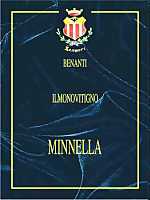
|
|
Minnella 2002 |
|
| Benanti (Italy) | |
| Grapes: Minnella | |
| Price: € 20,30 | Score: |
| The wine shows a pale straw yellow color and nuances of greenish yellow, very transparent. The nose reveals intense, clean, pleasing and elegant aromas which start with hints of pear and hawthorn followed by aromas of pineapple, banana, broom, apple, peach and plum. In the mouth has good correspondence to the nose, a crisp and pleasing round attack however balanced, good body, intense flavors. The finish is persistent with flavors of plum, pear and peach. | |
| Food Match: Vegetables soups, Risotto and pasta with mushrooms, Fried vegetables, Sauteed fish | |
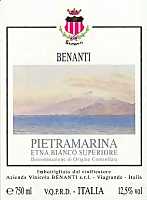
|
|
Etna Bianco Superiore Pietramarina 1998 |
|
| Benanti (Italy) | |
| Grapes: Carricante | |
| Price: € 22,50 | Score: |
| The wine shows a pale straw yellow color and nuances of straw yellow, very transparent. The nose reveals intense, clean, pleasing and refined aromas which start with hints of hawthorn, apple and pear followed by good aromas of pineapple, broom, white melon and pleasing hints of honey of orange blossoms and hazelnut. In the mouth has good correspondence to the nose, a crisp attack however well balances by alcohol, good body, intense flavors. The finish is persistent with flavors of apple, pineapple and a pleasing crisp hint. Pietramarina ages in tanks for at least one year followed by five months of aging in bottle. | |
| Food Match: Roasted fish, Fish soups, Pasta and risotto with fish | |
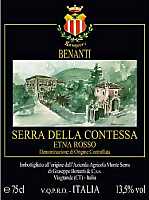
|
|
Etna Rosso Serra della Contessa 1999 |
|
| Benanti (Italy) | |
| Grapes: Nerello Mascalese (80%), Nerello Cappuccio (20%) | |
| Price: € 26,00 | Score: |
| The wine shows an intense ruby red color and nuances of ruby red, little transparency. The nose reveals good personality with intense, clean, pleasing, refined and elegant aromas that start with hints of black cherry, plum and raspberry followed by good aromas of blueberry, black pepper, violet, vanilla, licorice and a pleasing hint of cinchona. In the mouth has good correspondence to the nose, a slightly tannic attack however well balanced by alcohol, full body, intense flavors. The finish is persistent with flavors of plum, black cherry and raspberry. A well made wine. Serra della Contessa ages for more than one year in barrique followed by an aging in bottle of 12 months. | |
| Food Match: Roasted meat, Braised and stewed meat, Game, Hard cheese | |
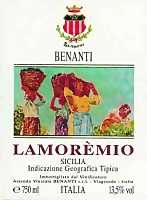
|
|
Lamorèmio 1999 |
|
| Benanti (Italy) | |
| Grapes: Nerello Mascalese (34%), Cabernet Sauvignon (33%), Nero d'Avola (33%) | |
| Price: € 19,20 | Score: |
| This wine shows an intense ruby red color and nuances of ruby red, little transparency. The nose denotes good personality with intense, clean, pleasing, refined and elegant aromas which start with aromas of black cherry, plum and blueberry followed by good aromas of violet, black pepper, licorice, toasted wood, vanilla and hints of cocoa. In the mouth has good correspondence to the nose, a tannic attack which slightly prevails, however balanced, full body, intense flavors. The finish is persistent with flavors of plum, black cherry and blueberry. A well made wine that will give its best with further aging. Lamorèmio ages for at least 18 months in barrique followed by at least 10 months of aging in bottle. | |
| Food Match: Roasted meat, Braised and stewed meat, Game, Hard cheese | |
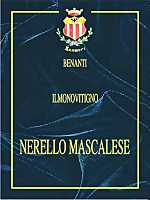
|
|
Nerello Mascalese 1999 |
|
| Benanti (Italy) | |
| Grapes: Nerello Mascalese | |
| Price: € 20,30 | Score: |
| This wine shows an intense ruby red color and nuances of ruby red, little transparency. The nose reveals intense, clean, pleasing and elegant aromas which start with hints of black cherry, blackberry and vanilla followed by good aromas of carob, blueberry, plum, tobacco, licorice and a pleasing hint of clover. In the mouth has good correspondence to the nose, a slightly tannic attack however well balanced by alcohol, good body, intense flavors. The finish is persistent with good flavors of plum, blackberry and black cherry. | |
| Food Match: Braised and stewed meat with mushrooms, Roasted meat, Game, Hard cheese | |
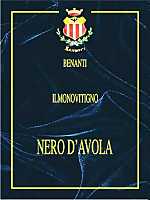
|
|
Nero d'Avola 1999 |
|
| Benanti (Italy) | |
| Grapes: Nero d'Avola | |
| Price: € 20,30 | Score: |
| The wine shows an intense ruby red color and nuances of ruby red, little transparency. The nose reveals intense, clean, pleasing and elegant aromas that start with hints of black cherry and plum followed by good aromas of carob, blueberry, violet, vanilla, toasted wood, tobacco and hints of caramel. In the mouth has good correspondence to the nose, a slightly tannic attack and however well balanced by alcohol, good body, intense flavors. The finish is persistent with pleasing flavors of black cherry, plum and blueberry. | |
| Food Match: Braised and stewed meat with mushrooms, Roasted meat, Game, Hard cheese | |
| Azienda Vinicola Benanti - Via Garibaldi, 475 - 95029 Viagrande, Catania (Italy) Tel. +39 95 7893438 / 7893533 Fax +39 95 7893677 - Winemaker: Salvo Foti Naselli - Established: 1992 - Production: 180.000 bottles - E-Mail: benanti@vinicolabenanti.it - WEB: www.vinicolabenanti.it |
Cellar Journal |
|
This section is reserved to wine producers who want to publish news and information about their business, to announce new products or just for communicating to its customers information and promotions about their products and activity. Send news to be published at our e-mail address.
|
A New Award for Quality WinesAfter the “Five Diamonds” award conferred to excellent wines, from January 2004 on will also be awarded wines that join good quality to a convenient price |
|
As it is already known both to our readers and to producers who ship their wines to us in order to be evaluated, the system used by our publication for expressing judgments about the quality of a wine is represented by diamonds and stars. Scores are expressed by a minimum of one diamond up to five diamonds, whereas the star is awarded to the wines that in their category have particular characteristics which distinguish them from the others. To the wines which have scored five diamonds, or five diamonds and one star, is conferred by the tasting committee a specific award which certifies the results obtained during our evaluations.
From January 2004 on, we decided to award those producers who are capable of offering to consumers good quality wines at a convenient price. Wines considered by our tasting committee as good value products, must score a minimum of three diamonds and not exceed a specific retail price. The limits for prices are set according to the specific categories of score and will be updated according to the condition of the market. Prices considered for the award will vary according to the category of the score: a five diamond wine considered as a good value product, will however be more expensive than a three or four diamonds wine. This new award introduces some modifications to the
Wines Guide as well as in the
reviews published on DiWineTaste. Every wine awarded as “Good Value” will be
marked in the Guide and in the reviews with the symbol of a sun in a red
background (
|
||||||||
News |
|
In this section will be published news and information about events concerning the world of wine and food. Whoever is interested in publishing this kind of information can send us a mail at our address.
|
Reading Wine LabelsOften considered as items to be collected, labels provide useful information about the origin and the characteristics of a wine, nevertheless their purpose is promotional as well as giving the bottle a proper identity |
|
Marketing studies have discovered that a consumer, in front of a rich offering of products belonging to the same category and exposed in a supermarket, most of the times bases his or her choice according to the message transmitted by the package. In that moment, in particular when he or she does not have any competence neither on the category of the product nor on the specific product as well, the choice is strongly influenced by appearance. Wine, a product which is getting more and more important in the market, is no exception. After all it is enough observing the evolution of the label in the past 15 years to realize graphic designers, advertisement and wineries have paid lots of attention on this essential tool of identification. In few years took place a progressive evolution of the label which has transformed it from a simple and sober look, almost essential, to a more pompous and colored form, and sometimes, so rich in decorative details that makes invisible the fundamental information it should communicate instead. Of course we are not interested, in this context, about the graphical and promotional evolution of the label, what is of interest to us is how to read it, while trying to understand what kind of information can be obtained by it. No matter the graphical aspect, wine labels must obey to strict and rigid norms and laws in force in many countries and must explicitly communicate information about the origin, the producer and the characteristics of wine. However these information, certainly useful for the consumer, cannot provide any information about the real quality of a wine, a condition which can be verified only and indisputably by tasting. The real quality of a wine, as well as of any other products, is not guaranteed by the information written on the label or by specific laws, quality is, first of all, a condition and a principle on which the producer bases his or her work. Of course it is of fundamental importance the existence of specific laws regulating the production of foods and beverages, therefore of wine as well, in order to ensure consumers on the essential requisites for a quality production and for preventing any fraud.
|
||||
|
Labels, in the course of the history of wine, have progressively contributed to a better identification of the product while making it more visible from the others. By comparing the labels used in bottles one century ago with the ones used today, it can be noticed their development and communicative role plays now a fundamental function. In the past wine labels were frequently handwritten and had essential and succinct information about the producer, name of wine, vintage and, sometimes, the area of origin. Nowadays, besides having these information, wine labels are richly colored and to the textual information have been added images, pictures and logos of every kind, form and color. Usually in bottles is not used one label only, there are other smaller labels as well, located in “secondary” positions, having the purpose of improving the identification of the bottle as well as providing supplementary information to the consumer about the characteristics of the wine. The label which mainly identifies a bottle is the one placed in the front side, generally having a larger size, and its composition is usually regulated by specific laws and norms in force in every country of the world. In the back side of the bottle is frequently found the so called “back label”, most of the times source of precious information about the wine and on the way it should be served and kept. The back label, generally smaller than the front label, in some cases must state special and mandatory information and “warnings” imposed by the laws in force in certain countries. To complete the “dress” of the label can also be used a “neck label”, a typical label found in sparkling wines and placed in the neck, besides having a decorative function, it frequently reports some characteristics of the wine, such as vintage. Other labels that can be found in a bottle are represented by the many “seals” of identification from producer consortiums or for the safeguarding of a specific wine, such as the renowned “black rooster” for Chianti Classico, as well as small labels which remind the consumer about award conferred to the wine or to the producer. Moreover, according to specific laws safeguarding the quality systems of the many countries, in bottles can also be found special seals conferred to the producer by specific government bureaus which are usually placed on the bottle's neck in order to guarantee both the quality of wine and its origin. An example of government seals is offered by Italian DOCG wines (Denominazione d'Origine Controllata e Garantita) and by South African WO wines (Wine of Origin).
|
|
No matter the efficient communicative and promotional role of the label, the most important and practical purpose for the consumer is to provide information about the nature and the characteristics of a wine. No matter how strict can be the laws in force in the many wine producing countries, a function that a label cannot ensure to the consumer is to provide information on the real quality of the wine. This guarantee is solely offered by the seriousness of the producer and, unfortunately, can be assessed only by tasting and by the evaluation of the product. Despite the label should provide, in theory, a fundamental guarantee about the quality of the product, experience and practice teach us wines coming from the same area but from different producers, whose production is regulated by the very same laws, indisputably have very different levels of quality from each other. Because of the number of laws in force in every country and regulating labelling, we will just discuss aspect which are common in every country of the world and that are virtually found in every label. For specific information about quality systems in force in the many countries of the world, whose effects influence the information stated on labels, we invite readers to read the articles published in the “ABC Wine” column.
In certain countries there are specific laws which regulate the labelling of wine bottles and force producers to warn consumers about the possible risks connected to the consumption of wine. Whereas it is completely and indisputably true that alcoholism is a social plague to be prevented and contrasted - we will always continue to say the pleasure and the wise appreciation of wine can only be realized with a moderate and wise consumption - it is disputable the nature of some norms. Generally it is reminded, in the country where these laws are in force, the consumption of wine can be cause of diseases as well as being detrimental for health, whereas there is no mention about the quantity that can be cause of such diseases. According to this point of view, it is not clear whether a single sip of wine can cause serious damages to health or it is needed a whole bottle or even a cask instead. Culture and civilization are also expressed by the honesty of certain assertions and certainly not by the indiscriminate generalization and approximation which are detrimental and give origin to alarmism and unjust prejudices. Once again, the abuse of alcohol is neither a favorable aspect nor something that can be agreed, it is a condition to be contrasted, and this can be done, first of all, by giving a honest and correct information. Moreover many medical researches on the effects of wine on health, suggest a moderate and wise consumption of wine is beneficial to the improvement and to the good keeping of health. This medical and scientific consideration seems to be in contrast with the generalization suggested by some warnings to be written by law in certain countries. As mentioned above, the information stated by law in labels vary from country to country, however some of them are virtually included in every labelling system and are now considered as common information in every bottle. The following list includes the information usually found in labels.
|
||||||||
CognacThe king of brandies, it is the result of the mastery of man and generosity of nature, a masterpiece unique in its kind |
|
Cognac is a distilled of wine which is produced after a long period of aging in oak casks. Cognac basically is a brandy, obtained by the distillation of wines produced in a particular area in France which is located around the city having the same name of the famous brandy. Cognac is a lovely city where the village landscapes, shaped by the years, reminds of traditions as ancient as cognac itself, where the smell of “part des anges” is in the air and the memory of histories, now lost in time, comes to mind and frees from the stressful modern times. The first written evidences of cognac are dated back to 1638 and the first bulk distillation took place about in the seventeenth century.
|
|
The origin of cognac is dated back to the 1600's. The area of production is located in France, precisely in the region of Charentes, with a small part in Dordogne and Deux Sèvres. The region, located in the western part of France, north from Bordeaux and with an area of about 80,000 hectares (about 198,000 acres), is favored by a climate particular suited for the cultivation of vine. It is in this region the Atlantic climate meets the continental climate and the whole region has recognized to the AOC rank (Appellation d'Origine Contrôlée). The area has been regulated by the so called “cru map”, emanated in 1909, which divides the region into six official wine areas, called “cru”. These areas are called as follows:
The division of the areas was determined according to the calcareous percentage of soils and according to local climate. In order to safeguarding the quality of the product they also decided to regulate the type of vines allowed for the production of the brandy. The main grape used for the production of cognac is Ugni Blanc, name with which Trebbiano Toscano is known in France and locally called Saint-Emilion. Other grapes used for the production of cognac, although marginally, are Folle Blanche and Colombard. Wines produced with these grapes are very light, with a low percentage of alcohol and a high percentage of acidity, particularly suited for distillation. Every area has a proper climate and soil which contribute to characterize every vineyard and producing wines, therefore brandies, with different organoleptic qualities and different aging capacities. The area and the raw matter are not the only factors which characterize the brandy: in the production of cognac the distillation technique is of fundamental importance. Wines from the “Grande Champagne” and the “Petite Champagne” produce very aromatic brandies, with floral and fruity hints, which become very elegant after a long aging. In the “Borderies” area are produced famous brandies having the characteristic aroma of violet, and when allowed to age for many years, they become bodied and round. The areas of “Bois” produce the most robust brandies, and thanks to their capacity of aging quickly, they are very appreciated in the production of blends.
|
||||||||
|
Wines coming from the many crus are brought in wintertime to distilleries and are distilled separately in order to keep the characteristics and qualities of each one. In this phase is held in consideration every difference: every peculiarity must be protected from uniformity, a characteristic that will be delegated to blending. The process of distillation takes place between September 1st and March 31st, a period which has not changed in the course of time, by using stills known as “Charentais” and whose origin is dated back to the fifteenth century. Stills are strictly made of copper which, besides ensuring a good resistance and a high thermal conductivity, prevent the development of acid fats. This characteristic prevents the risk of spoiling the brandy with unpleasing smells and flavors. The boiler of stills are onion shaped and has on the top a dome which collects and directs the steam. From the top of the dome there is a pipe, called “swan neck”, connected to a serpentine that from the top of the boiler submerges in a refrigerating liquid and therefore arrives of a container in which the distilled liquid is collected. The process consists in two ebullitions called “chauffes”. This process of double ebullition, allows the production of brandies with particular finesse and purity, a distillation technique which has never changed during the course of time. The distillation process begins by filling the boiler with wine. The wine is then heated at a moderate temperature, for about 8-10 hours, and produces an alcoholic steam which raises and pass through the circuit of serpentine. In this phase the steam cools down and condense and reach the end of the circuit where the liquid is collected in a container. From the first phase is obtained a milky liquid, thick, with little aromas and a low percentage of alcohol, called “bruillis”. At the end of the first ebullition the process is repeated by using the “raw” brandy. The second ebullition, called “la bonne chauffe”, is the most important one and lasts about 12 hours. It is a very delicate process which requires a great mastery of the operators as they will have to eliminate the head and the tail, that is the first and the last part of the liquid, while keeping the central part only, the famous “heart” of the brandy. The product obtained from the first distillation has a pretty low percentage of alcohol, whereas the second one gives a brandy with about 70% of alcohol. The end of the two distillation processes just represents the first phase of the production: the distilled brandy will require two more phases in order to become cognac which will be finally commercialized. The next phase is aging. The brandy is put in 350 liters casks (about 92 Gallons) made of oak from the forests of Limousin and Tronçais. This particular wood confer to cognac an amber color while slowly passing its aromas to the brandy as well as tannins and lignin. The porosity of the wood also favors the evaporation of a pretty high quantity of cognac of about hundreds of casks per year: the so called “part des anges”, that is the part of angels. Aging is a phase that can last from a minimum of 30 months up to tens of years. The maximum aging for a cognac is of 60 years, beyond this period it gets a bitter and rough character. The duration of aging also depends on the type of wine used for distillation as well as the decisions of producers and climate.
The production of cognac is made by little steps, all of them very important, and each one contributes to the final quality. Neither extra old cognacs are left in the cask more than the time needed: they are poured in demijohns, called “bonbonnes”, and kept in special rooms called “paradis”. The cellar is rigorously and continuously controlled. A room having the right percentage of humidity allows the right releasing of water and alcohol from casks: a condition that must be constant over time and for all the duration of aging. Cellars where casks of cognac are held have gray colored walls: this color is not chosen by men, it is because of the presence of a microscopic mould called Torula Compniacensis, which develops in these particular conditions and gets nourishment from the alcohol evaporating from casks. The last phase of the production, following aging, is blending, the so called assemblage. This delicate operation is done by the “master of cellar” (maitre de chai), who decides the duration of aging of every single cognac. This phase consists in the dilution and the blending of cognacs from different vintages and vineyards in order to get the very best quality: a homogeneous and harmonious product. Traditionally, most of distilleries make use of brandies older than what required by law in order to obtain a particularly favorable assemblage or to keep the quality of the product high and constant. Assemblage also consists in diluting cognac with spring water, or distilled water, in order to lower the percentage of alcohol down to about 40%. Cognac is finally bottled and released on the market therefore making it available in shops all over the world. The quality of a cognac is also determined by its age, which is not expressed in years, but with proper abbreviations and terms. The age of the younger cognac used for the blend determines the denomination of aging. Moreover, as opposed to wine, the age of cognac is determined according to the time spent in a cask, whereas the time spent in a bottle does not affect the aging of brandy. The definitions used to indicate the age of a cognac are the following:
In case at least 50% of the brandies used in the blend come from the areas of Grande Champagne and Petite Champagne, the cognac can be defined as “Fine Champagne”.
|
||||||||
|
The best glass for tasting cognac is the tulip shaped glass which with the narrowing of the opening directs the aromas towards the nose. Connoisseurs prefer drinking cognac plain, in the characteristic tulip shaped or balloon shaped glasses, at an ideal temperature of about 20°-22° C (68°-71° F), solely warmed, when needed, by the heat of the hand which helps to free its unmistakable and unique aromas. In wintertime it is used as a base ingredient in many hot beverages, whereas in summertime it can be used for the preparation of thirst quenching long drinks. Of course it is also an important ingredient in many cocktails which contributes, with its bouquet, to enrich and characterize every creation of “blended drinks”. There are many international cocktails which make use of cognac, among the most famous one there is Sidecar, whose name derives from its inventor: a postman. It seems that a postman, who used a sidecar for its job, during the cold winter evenings, used to stop by a bar, which was located along the road, and ordered a cognac with ice and cointreau. That's how the recipe was born: 2/4 of cognac, 1/4 of cointreau, 1/4 of lemon juice. Cognac also allows interesting matchings, very famous, such as with chocolate. Among smokers it is frequent to match cognac with cigars: a marriage, they say, which is very happy.
|
||||
Wine Parade |
|
|
| The best 15 wines according to DiWineTaste's readers. To express your best three wines send us an E-mail or fill in the form available at our WEB site. |
| Rank | Wine, Producer | |
|---|---|---|
| 1 |
| Franciacorta Cuvée Annamaria Clementi 1996, Ca' del Bosco (Italy) |
| 2 |
| Fumé Blanc Napa Valley 2001, Grgich Hills (USA) |
| 3 |
| Alto Adige Gewürztraminer Kolbenhof 2002, Hofstätter (Italy) |
| 4 |
| Margaux 2000, Ségla (France) |
| 5 |
| Masseto 1998, Tenuta dell'Ornellaia (Italy) |
| 6 |
| Colli Bolognesi Pignoletto Superiore “Prova d'Autore” 2001, Bonfiglio (Italy) |
| 7 |
| Teroldego Rotaliano Granato 1998, Foradori (Italy) |
| 8 |
| Syrah Winemaker's Lot Vic 3, Concha y Toro (Chile) |
| 9 |
| Capo di Stato 1998, Conte Loredan Gasparin (Italy) |
| 10 |
| Barolo Brunate 1999, Enzo Boglietti (Italy) |
| 11 |
| Sauvignon Blanc Reserve Marlborough 2002, Kaituna Hills (New Zealand) |
| 12 |
| Turriga 1998, Argiolas (Italy) |
| 13 |
| Sauvignon Blanc 2000, Cakebread (USA) |
| 14 |
| Shiraz 2000, Plantaganet (Australia) |
| 15 |
| Château Laroque Saint-Émilion Grand Cru Classè 1998 (France) |
| |||||||
Privacy Policy | |||||||


| Copyright © 2002-2024 Antonello Biancalana, DiWineTaste - All rights reserved |
| All rights reserved under international copyright conventions. No part of this publication and of this WEB site may be
reproduced or utilized in any form or by any means, electronic or mechanical, without permission in writing from DiWineTaste. |